HND in Travel & Tourism: Career Development Plan & Management Skills
VerifiedAdded on 2023/05/29
|18
|4527
|249
Report
AI Summary
This report assesses various management styles, leadership characteristics, communication processes, and organizational culture within the context of the Hilton Group and White Chapel tourism development. It includes a self-assessment of management skills, a SWOT analysis, and the formulation of objectives and targets for personal and professional development. The report also addresses team leadership, decision-making, and the creation of a career development plan, linking managerial skills to future career aspirations. This document is available on Desklib, a platform offering a wide range of study tools and solved assignments for students.
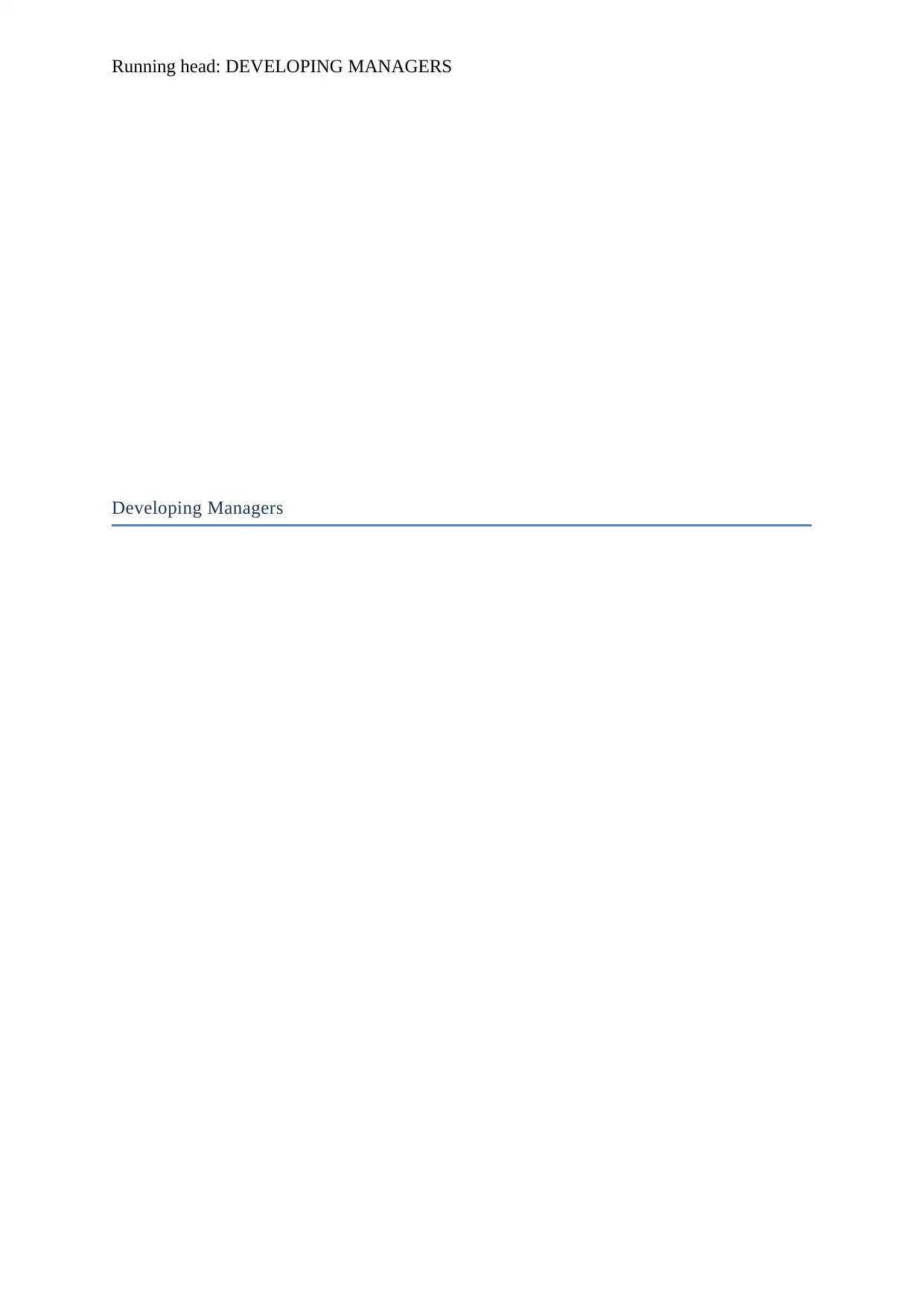
Running head: DEVELOPING MANAGERS
Developing Managers
Developing Managers
Paraphrase This Document
Need a fresh take? Get an instant paraphrase of this document with our AI Paraphraser
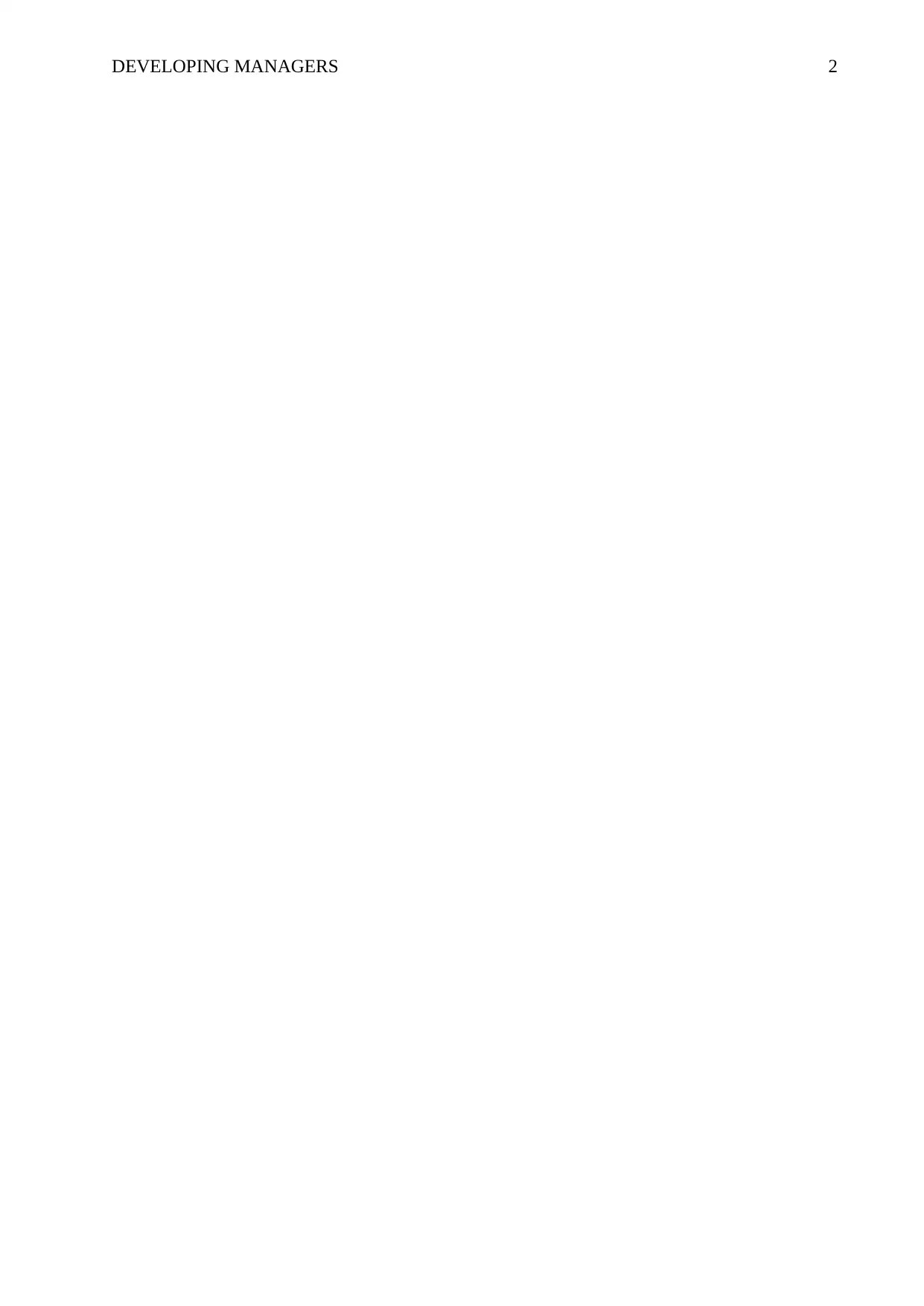
DEVELOPING MANAGERS 2
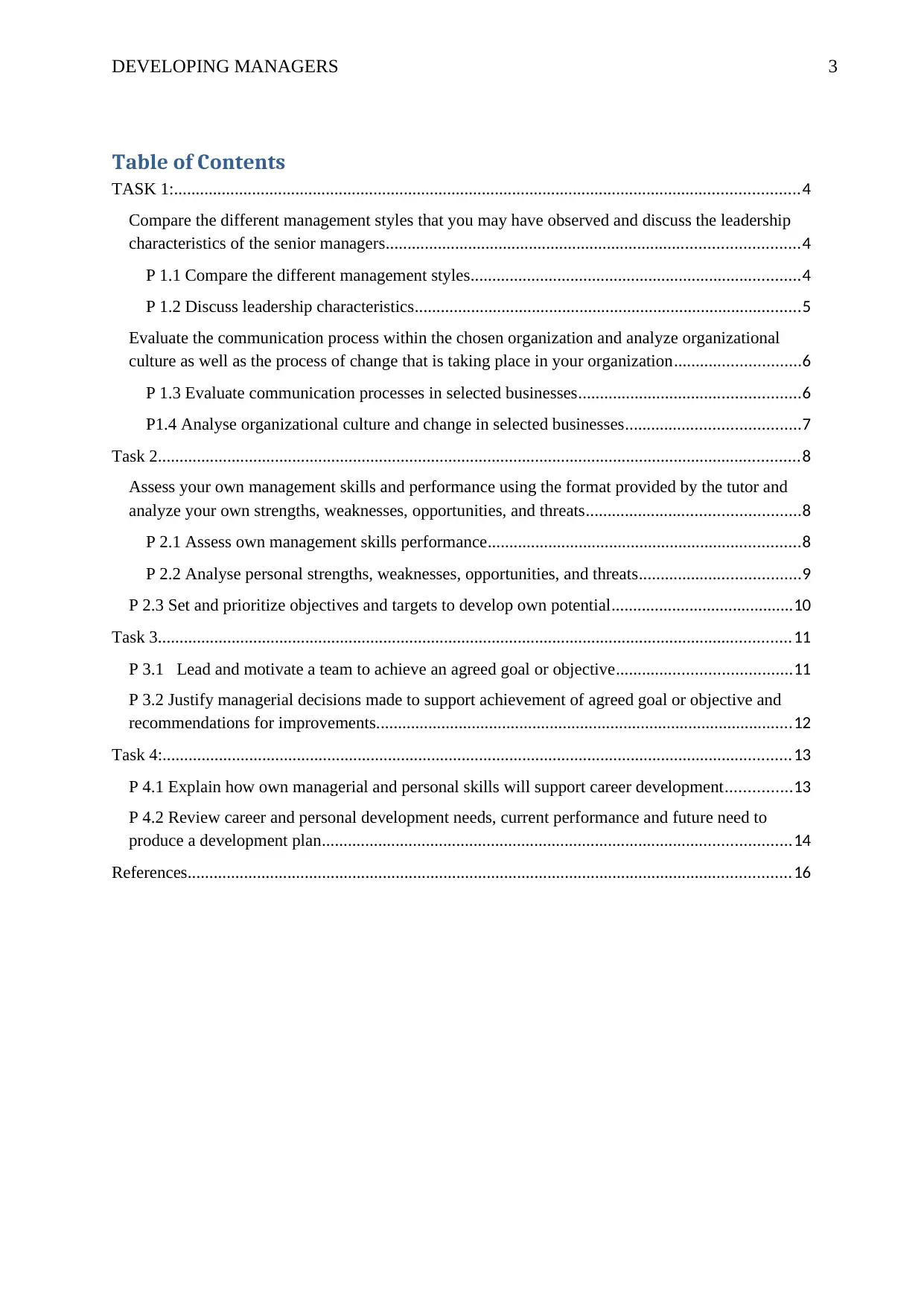
DEVELOPING MANAGERS 3
Table of Contents
TASK 1:................................................................................................................................................4
Compare the different management styles that you may have observed and discuss the leadership
characteristics of the senior managers...............................................................................................4
P 1.1 Compare the different management styles............................................................................4
P 1.2 Discuss leadership characteristics.........................................................................................5
Evaluate the communication process within the chosen organization and analyze organizational
culture as well as the process of change that is taking place in your organization.............................6
P 1.3 Evaluate communication processes in selected businesses...................................................6
P1.4 Analyse organizational culture and change in selected businesses........................................7
Task 2....................................................................................................................................................8
Assess your own management skills and performance using the format provided by the tutor and
analyze your own strengths, weaknesses, opportunities, and threats.................................................8
P 2.1 Assess own management skills performance........................................................................8
P 2.2 Analyse personal strengths, weaknesses, opportunities, and threats.....................................9
P 2.3 Set and prioritize objectives and targets to develop own potential..........................................10
Task 3..................................................................................................................................................11
P 3.1 Lead and motivate a team to achieve an agreed goal or objective........................................11
P 3.2 Justify managerial decisions made to support achievement of agreed goal or objective and
recommendations for improvements................................................................................................12
Task 4:.................................................................................................................................................13
P 4.1 Explain how own managerial and personal skills will support career development...............13
P 4.2 Review career and personal development needs, current performance and future need to
produce a development plan............................................................................................................14
References...........................................................................................................................................16
Table of Contents
TASK 1:................................................................................................................................................4
Compare the different management styles that you may have observed and discuss the leadership
characteristics of the senior managers...............................................................................................4
P 1.1 Compare the different management styles............................................................................4
P 1.2 Discuss leadership characteristics.........................................................................................5
Evaluate the communication process within the chosen organization and analyze organizational
culture as well as the process of change that is taking place in your organization.............................6
P 1.3 Evaluate communication processes in selected businesses...................................................6
P1.4 Analyse organizational culture and change in selected businesses........................................7
Task 2....................................................................................................................................................8
Assess your own management skills and performance using the format provided by the tutor and
analyze your own strengths, weaknesses, opportunities, and threats.................................................8
P 2.1 Assess own management skills performance........................................................................8
P 2.2 Analyse personal strengths, weaknesses, opportunities, and threats.....................................9
P 2.3 Set and prioritize objectives and targets to develop own potential..........................................10
Task 3..................................................................................................................................................11
P 3.1 Lead and motivate a team to achieve an agreed goal or objective........................................11
P 3.2 Justify managerial decisions made to support achievement of agreed goal or objective and
recommendations for improvements................................................................................................12
Task 4:.................................................................................................................................................13
P 4.1 Explain how own managerial and personal skills will support career development...............13
P 4.2 Review career and personal development needs, current performance and future need to
produce a development plan............................................................................................................14
References...........................................................................................................................................16
⊘ This is a preview!⊘
Do you want full access?
Subscribe today to unlock all pages.

Trusted by 1+ million students worldwide
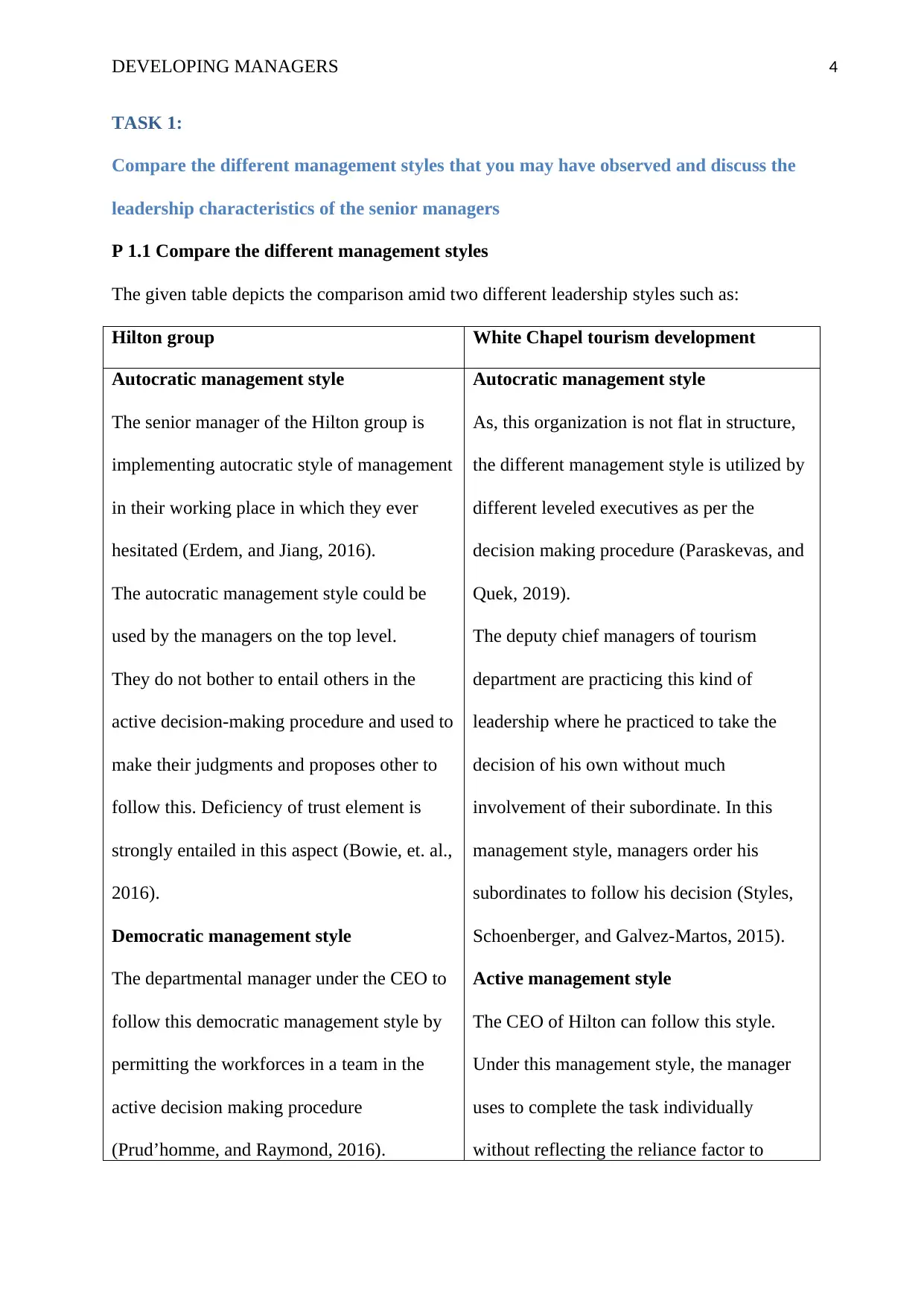
DEVELOPING MANAGERS 4
TASK 1:
Compare the different management styles that you may have observed and discuss the
leadership characteristics of the senior managers
P 1.1 Compare the different management styles
The given table depicts the comparison amid two different leadership styles such as:
Hilton group White Chapel tourism development
Autocratic management style
The senior manager of the Hilton group is
implementing autocratic style of management
in their working place in which they ever
hesitated (Erdem, and Jiang, 2016).
The autocratic management style could be
used by the managers on the top level.
They do not bother to entail others in the
active decision-making procedure and used to
make their judgments and proposes other to
follow this. Deficiency of trust element is
strongly entailed in this aspect (Bowie, et. al.,
2016).
Democratic management style
The departmental manager under the CEO to
follow this democratic management style by
permitting the workforces in a team in the
active decision making procedure
(Prud’homme, and Raymond, 2016).
Autocratic management style
As, this organization is not flat in structure,
the different management style is utilized by
different leveled executives as per the
decision making procedure (Paraskevas, and
Quek, 2019).
The deputy chief managers of tourism
department are practicing this kind of
leadership where he practiced to take the
decision of his own without much
involvement of their subordinate. In this
management style, managers order his
subordinates to follow his decision (Styles,
Schoenberger, and Galvez-Martos, 2015).
Active management style
The CEO of Hilton can follow this style.
Under this management style, the manager
uses to complete the task individually
without reflecting the reliance factor to
TASK 1:
Compare the different management styles that you may have observed and discuss the
leadership characteristics of the senior managers
P 1.1 Compare the different management styles
The given table depicts the comparison amid two different leadership styles such as:
Hilton group White Chapel tourism development
Autocratic management style
The senior manager of the Hilton group is
implementing autocratic style of management
in their working place in which they ever
hesitated (Erdem, and Jiang, 2016).
The autocratic management style could be
used by the managers on the top level.
They do not bother to entail others in the
active decision-making procedure and used to
make their judgments and proposes other to
follow this. Deficiency of trust element is
strongly entailed in this aspect (Bowie, et. al.,
2016).
Democratic management style
The departmental manager under the CEO to
follow this democratic management style by
permitting the workforces in a team in the
active decision making procedure
(Prud’homme, and Raymond, 2016).
Autocratic management style
As, this organization is not flat in structure,
the different management style is utilized by
different leveled executives as per the
decision making procedure (Paraskevas, and
Quek, 2019).
The deputy chief managers of tourism
department are practicing this kind of
leadership where he practiced to take the
decision of his own without much
involvement of their subordinate. In this
management style, managers order his
subordinates to follow his decision (Styles,
Schoenberger, and Galvez-Martos, 2015).
Active management style
The CEO of Hilton can follow this style.
Under this management style, the manager
uses to complete the task individually
without reflecting the reliance factor to
Paraphrase This Document
Need a fresh take? Get an instant paraphrase of this document with our AI Paraphraser
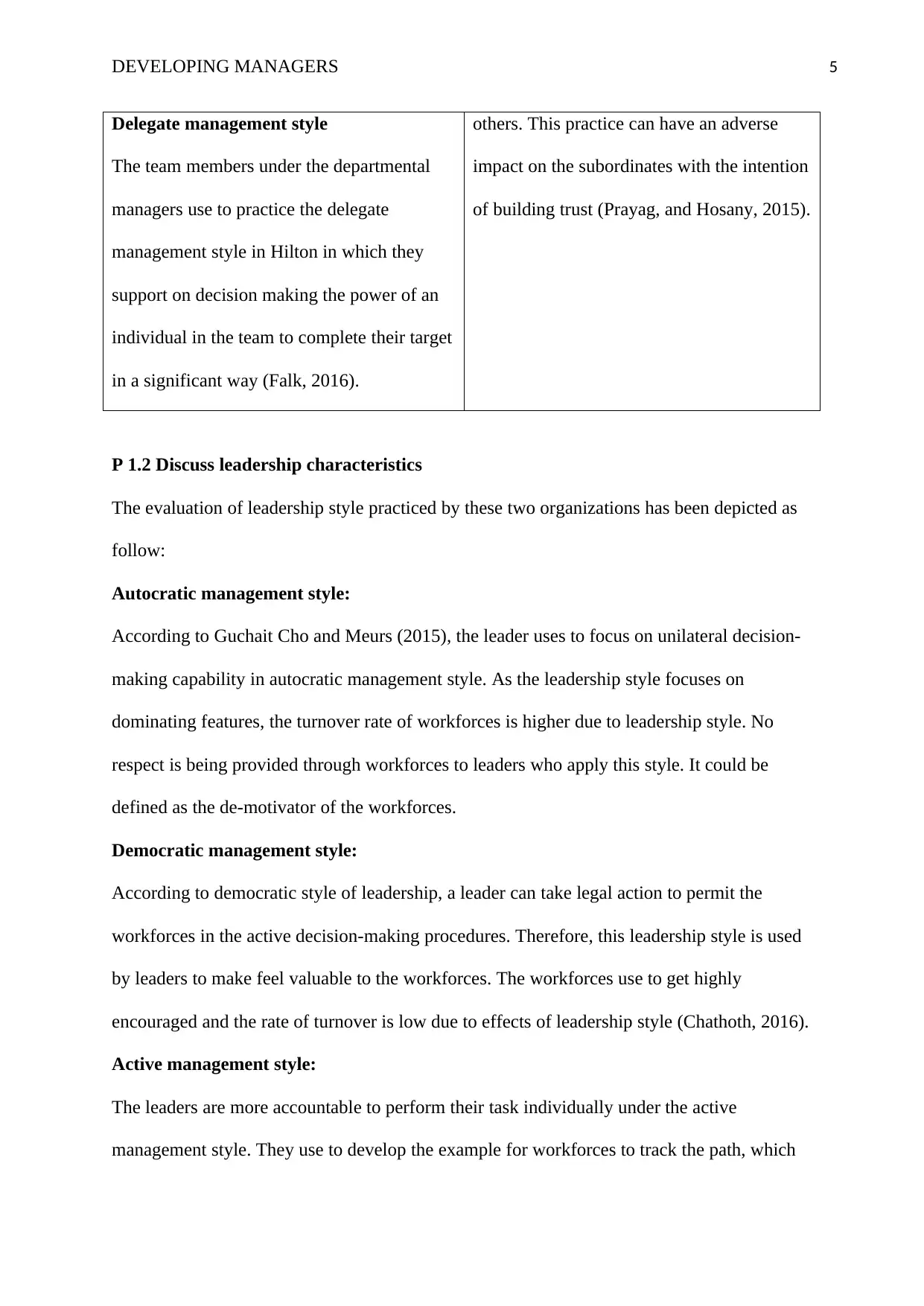
DEVELOPING MANAGERS 5
Delegate management style
The team members under the departmental
managers use to practice the delegate
management style in Hilton in which they
support on decision making the power of an
individual in the team to complete their target
in a significant way (Falk, 2016).
others. This practice can have an adverse
impact on the subordinates with the intention
of building trust (Prayag, and Hosany, 2015).
P 1.2 Discuss leadership characteristics
The evaluation of leadership style practiced by these two organizations has been depicted as
follow:
Autocratic management style:
According to Guchait Cho and Meurs (2015), the leader uses to focus on unilateral decision-
making capability in autocratic management style. As the leadership style focuses on
dominating features, the turnover rate of workforces is higher due to leadership style. No
respect is being provided through workforces to leaders who apply this style. It could be
defined as the de-motivator of the workforces.
Democratic management style:
According to democratic style of leadership, a leader can take legal action to permit the
workforces in the active decision-making procedures. Therefore, this leadership style is used
by leaders to make feel valuable to the workforces. The workforces use to get highly
encouraged and the rate of turnover is low due to effects of leadership style (Chathoth, 2016).
Active management style:
The leaders are more accountable to perform their task individually under the active
management style. They use to develop the example for workforces to track the path, which
Delegate management style
The team members under the departmental
managers use to practice the delegate
management style in Hilton in which they
support on decision making the power of an
individual in the team to complete their target
in a significant way (Falk, 2016).
others. This practice can have an adverse
impact on the subordinates with the intention
of building trust (Prayag, and Hosany, 2015).
P 1.2 Discuss leadership characteristics
The evaluation of leadership style practiced by these two organizations has been depicted as
follow:
Autocratic management style:
According to Guchait Cho and Meurs (2015), the leader uses to focus on unilateral decision-
making capability in autocratic management style. As the leadership style focuses on
dominating features, the turnover rate of workforces is higher due to leadership style. No
respect is being provided through workforces to leaders who apply this style. It could be
defined as the de-motivator of the workforces.
Democratic management style:
According to democratic style of leadership, a leader can take legal action to permit the
workforces in the active decision-making procedures. Therefore, this leadership style is used
by leaders to make feel valuable to the workforces. The workforces use to get highly
encouraged and the rate of turnover is low due to effects of leadership style (Chathoth, 2016).
Active management style:
The leaders are more accountable to perform their task individually under the active
management style. They use to develop the example for workforces to track the path, which
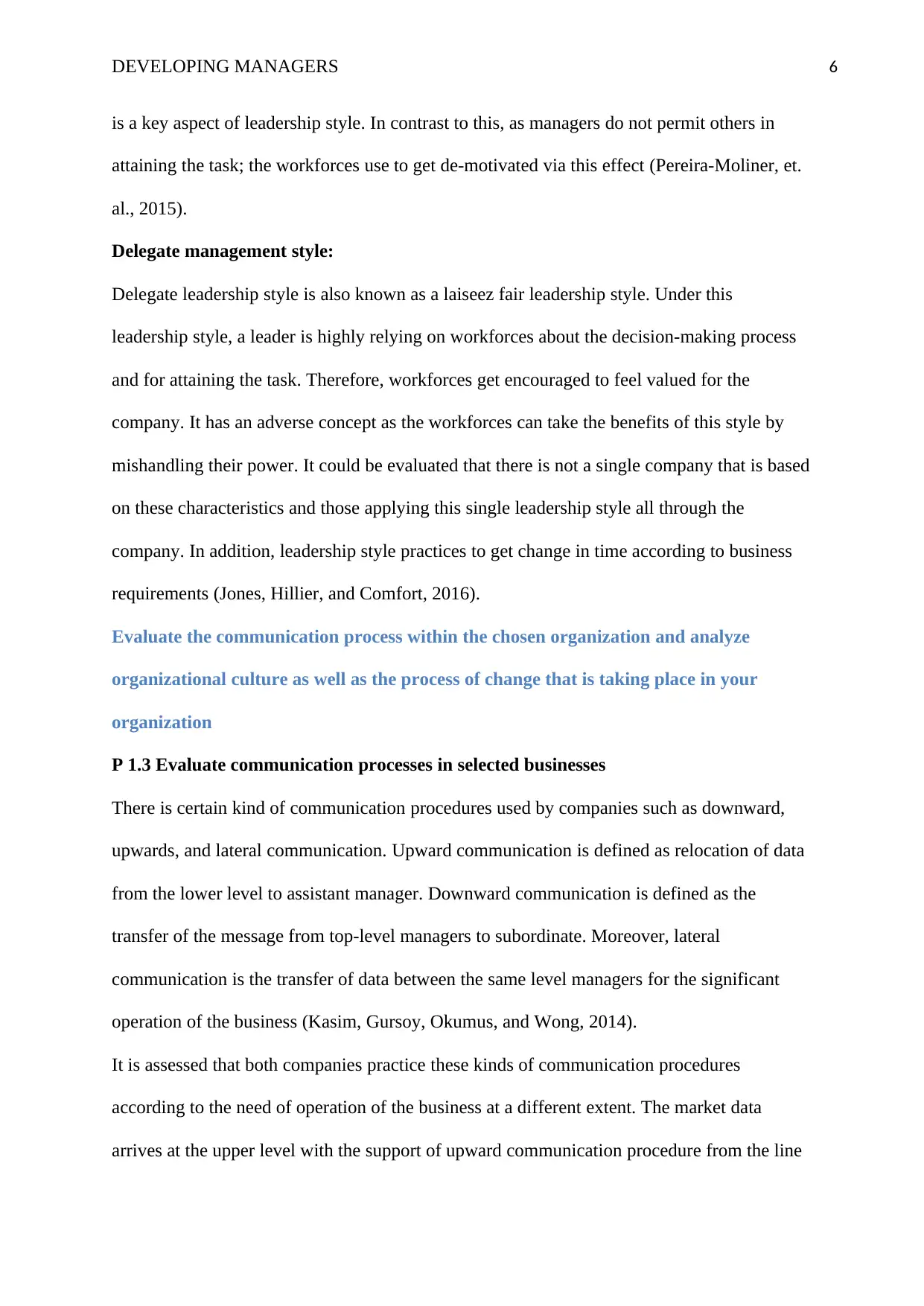
DEVELOPING MANAGERS 6
is a key aspect of leadership style. In contrast to this, as managers do not permit others in
attaining the task; the workforces use to get de-motivated via this effect (Pereira-Moliner, et.
al., 2015).
Delegate management style:
Delegate leadership style is also known as a laiseez fair leadership style. Under this
leadership style, a leader is highly relying on workforces about the decision-making process
and for attaining the task. Therefore, workforces get encouraged to feel valued for the
company. It has an adverse concept as the workforces can take the benefits of this style by
mishandling their power. It could be evaluated that there is not a single company that is based
on these characteristics and those applying this single leadership style all through the
company. In addition, leadership style practices to get change in time according to business
requirements (Jones, Hillier, and Comfort, 2016).
Evaluate the communication process within the chosen organization and analyze
organizational culture as well as the process of change that is taking place in your
organization
P 1.3 Evaluate communication processes in selected businesses
There is certain kind of communication procedures used by companies such as downward,
upwards, and lateral communication. Upward communication is defined as relocation of data
from the lower level to assistant manager. Downward communication is defined as the
transfer of the message from top-level managers to subordinate. Moreover, lateral
communication is the transfer of data between the same level managers for the significant
operation of the business (Kasim, Gursoy, Okumus, and Wong, 2014).
It is assessed that both companies practice these kinds of communication procedures
according to the need of operation of the business at a different extent. The market data
arrives at the upper level with the support of upward communication procedure from the line
is a key aspect of leadership style. In contrast to this, as managers do not permit others in
attaining the task; the workforces use to get de-motivated via this effect (Pereira-Moliner, et.
al., 2015).
Delegate management style:
Delegate leadership style is also known as a laiseez fair leadership style. Under this
leadership style, a leader is highly relying on workforces about the decision-making process
and for attaining the task. Therefore, workforces get encouraged to feel valued for the
company. It has an adverse concept as the workforces can take the benefits of this style by
mishandling their power. It could be evaluated that there is not a single company that is based
on these characteristics and those applying this single leadership style all through the
company. In addition, leadership style practices to get change in time according to business
requirements (Jones, Hillier, and Comfort, 2016).
Evaluate the communication process within the chosen organization and analyze
organizational culture as well as the process of change that is taking place in your
organization
P 1.3 Evaluate communication processes in selected businesses
There is certain kind of communication procedures used by companies such as downward,
upwards, and lateral communication. Upward communication is defined as relocation of data
from the lower level to assistant manager. Downward communication is defined as the
transfer of the message from top-level managers to subordinate. Moreover, lateral
communication is the transfer of data between the same level managers for the significant
operation of the business (Kasim, Gursoy, Okumus, and Wong, 2014).
It is assessed that both companies practice these kinds of communication procedures
according to the need of operation of the business at a different extent. The market data
arrives at the upper level with the support of upward communication procedure from the line
⊘ This is a preview!⊘
Do you want full access?
Subscribe today to unlock all pages.

Trusted by 1+ million students worldwide
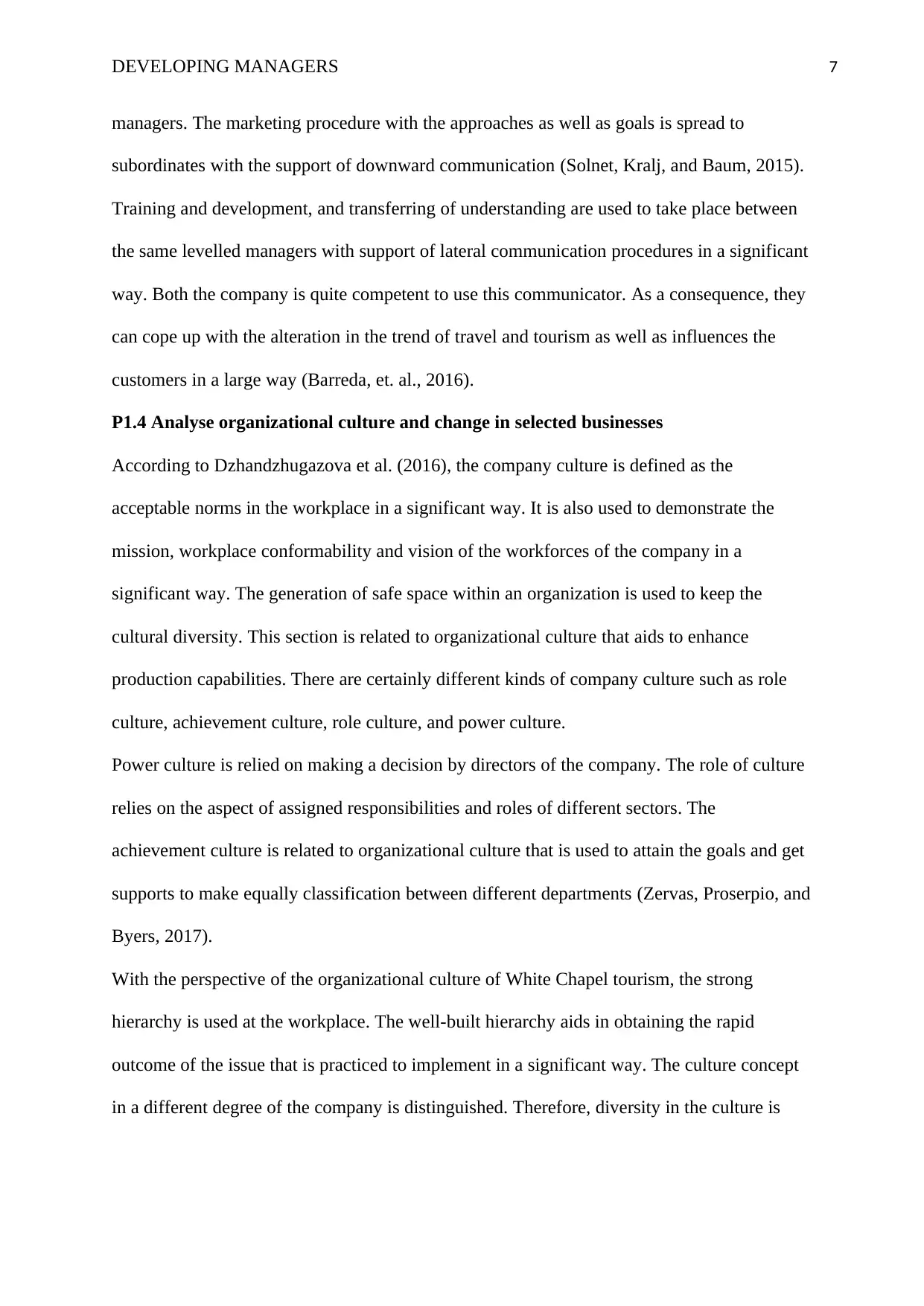
DEVELOPING MANAGERS 7
managers. The marketing procedure with the approaches as well as goals is spread to
subordinates with the support of downward communication (Solnet, Kralj, and Baum, 2015).
Training and development, and transferring of understanding are used to take place between
the same levelled managers with support of lateral communication procedures in a significant
way. Both the company is quite competent to use this communicator. As a consequence, they
can cope up with the alteration in the trend of travel and tourism as well as influences the
customers in a large way (Barreda, et. al., 2016).
P1.4 Analyse organizational culture and change in selected businesses
According to Dzhandzhugazova et al. (2016), the company culture is defined as the
acceptable norms in the workplace in a significant way. It is also used to demonstrate the
mission, workplace conformability and vision of the workforces of the company in a
significant way. The generation of safe space within an organization is used to keep the
cultural diversity. This section is related to organizational culture that aids to enhance
production capabilities. There are certainly different kinds of company culture such as role
culture, achievement culture, role culture, and power culture.
Power culture is relied on making a decision by directors of the company. The role of culture
relies on the aspect of assigned responsibilities and roles of different sectors. The
achievement culture is related to organizational culture that is used to attain the goals and get
supports to make equally classification between different departments (Zervas, Proserpio, and
Byers, 2017).
With the perspective of the organizational culture of White Chapel tourism, the strong
hierarchy is used at the workplace. The well-built hierarchy aids in obtaining the rapid
outcome of the issue that is practiced to implement in a significant way. The culture concept
in a different degree of the company is distinguished. Therefore, diversity in the culture is
managers. The marketing procedure with the approaches as well as goals is spread to
subordinates with the support of downward communication (Solnet, Kralj, and Baum, 2015).
Training and development, and transferring of understanding are used to take place between
the same levelled managers with support of lateral communication procedures in a significant
way. Both the company is quite competent to use this communicator. As a consequence, they
can cope up with the alteration in the trend of travel and tourism as well as influences the
customers in a large way (Barreda, et. al., 2016).
P1.4 Analyse organizational culture and change in selected businesses
According to Dzhandzhugazova et al. (2016), the company culture is defined as the
acceptable norms in the workplace in a significant way. It is also used to demonstrate the
mission, workplace conformability and vision of the workforces of the company in a
significant way. The generation of safe space within an organization is used to keep the
cultural diversity. This section is related to organizational culture that aids to enhance
production capabilities. There are certainly different kinds of company culture such as role
culture, achievement culture, role culture, and power culture.
Power culture is relied on making a decision by directors of the company. The role of culture
relies on the aspect of assigned responsibilities and roles of different sectors. The
achievement culture is related to organizational culture that is used to attain the goals and get
supports to make equally classification between different departments (Zervas, Proserpio, and
Byers, 2017).
With the perspective of the organizational culture of White Chapel tourism, the strong
hierarchy is used at the workplace. The well-built hierarchy aids in obtaining the rapid
outcome of the issue that is practiced to implement in a significant way. The culture concept
in a different degree of the company is distinguished. Therefore, diversity in the culture is
Paraphrase This Document
Need a fresh take? Get an instant paraphrase of this document with our AI Paraphraser

DEVELOPING MANAGERS 8
strongly kept at the workplace. The role culture is relied on the act as well as the
accountabilities are highly kept at the workplace (Kandampully, Bilgihan, and Zhang, 2016).
With the discussion of a cultural aspect of Hilton, it could be evaluated that empowering the
workforces is the key cultural concept of the company. The power culture is strong here as
the organization is family owned trade up till now. With the support of power culture, both
companies may adequately sustain their brand name within the market in a significant way by
attaining the market trend (Madera, Dawson, and Neal, 2017).
Task 2
Assess your own management skills and performance using the format provided by the
tutor and analyze your own strengths, weaknesses, opportunities, and threats
LO2 Be able to review own potential as a prospective manager
This part has evaluated about the performance level and skills of management style applied
through general manager in this company. In this section, role of General Manager in
Dorchester Luxury Hotel, London is assumed.
P 2.1 Assess own management skills performance
The management skill is the combination of diverse skills that is required for a leader. As per
the democratic management style, general manager allocates roles and responsibilities of
subordinates. Dorchester Luxury Hotel, London is the five-star hotels and this is a most
renowned hotel at the heart of London and the attractiveness is from post World War II
(Wang, et. al., 2016). The management proficiency that the general manager uses are as
follow:
Permitting the workforces in judicial procedure in order to attain the target of the
company about consumer satisfaction and good services
strongly kept at the workplace. The role culture is relied on the act as well as the
accountabilities are highly kept at the workplace (Kandampully, Bilgihan, and Zhang, 2016).
With the discussion of a cultural aspect of Hilton, it could be evaluated that empowering the
workforces is the key cultural concept of the company. The power culture is strong here as
the organization is family owned trade up till now. With the support of power culture, both
companies may adequately sustain their brand name within the market in a significant way by
attaining the market trend (Madera, Dawson, and Neal, 2017).
Task 2
Assess your own management skills and performance using the format provided by the
tutor and analyze your own strengths, weaknesses, opportunities, and threats
LO2 Be able to review own potential as a prospective manager
This part has evaluated about the performance level and skills of management style applied
through general manager in this company. In this section, role of General Manager in
Dorchester Luxury Hotel, London is assumed.
P 2.1 Assess own management skills performance
The management skill is the combination of diverse skills that is required for a leader. As per
the democratic management style, general manager allocates roles and responsibilities of
subordinates. Dorchester Luxury Hotel, London is the five-star hotels and this is a most
renowned hotel at the heart of London and the attractiveness is from post World War II
(Wang, et. al., 2016). The management proficiency that the general manager uses are as
follow:
Permitting the workforces in judicial procedure in order to attain the target of the
company about consumer satisfaction and good services
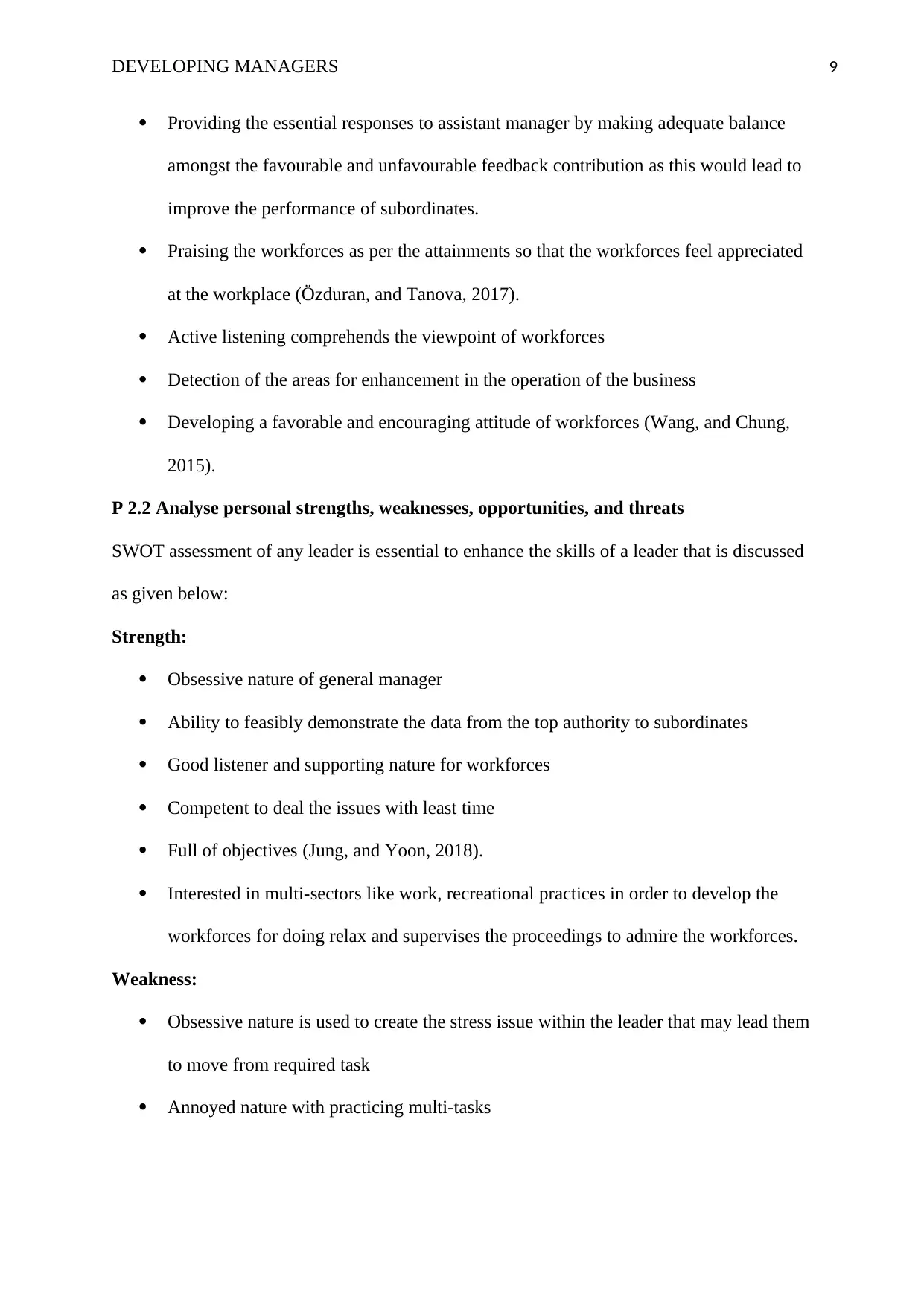
DEVELOPING MANAGERS 9
Providing the essential responses to assistant manager by making adequate balance
amongst the favourable and unfavourable feedback contribution as this would lead to
improve the performance of subordinates.
Praising the workforces as per the attainments so that the workforces feel appreciated
at the workplace (Özduran, and Tanova, 2017).
Active listening comprehends the viewpoint of workforces
Detection of the areas for enhancement in the operation of the business
Developing a favorable and encouraging attitude of workforces (Wang, and Chung,
2015).
P 2.2 Analyse personal strengths, weaknesses, opportunities, and threats
SWOT assessment of any leader is essential to enhance the skills of a leader that is discussed
as given below:
Strength:
Obsessive nature of general manager
Ability to feasibly demonstrate the data from the top authority to subordinates
Good listener and supporting nature for workforces
Competent to deal the issues with least time
Full of objectives (Jung, and Yoon, 2018).
Interested in multi-sectors like work, recreational practices in order to develop the
workforces for doing relax and supervises the proceedings to admire the workforces.
Weakness:
Obsessive nature is used to create the stress issue within the leader that may lead them
to move from required task
Annoyed nature with practicing multi-tasks
Providing the essential responses to assistant manager by making adequate balance
amongst the favourable and unfavourable feedback contribution as this would lead to
improve the performance of subordinates.
Praising the workforces as per the attainments so that the workforces feel appreciated
at the workplace (Özduran, and Tanova, 2017).
Active listening comprehends the viewpoint of workforces
Detection of the areas for enhancement in the operation of the business
Developing a favorable and encouraging attitude of workforces (Wang, and Chung,
2015).
P 2.2 Analyse personal strengths, weaknesses, opportunities, and threats
SWOT assessment of any leader is essential to enhance the skills of a leader that is discussed
as given below:
Strength:
Obsessive nature of general manager
Ability to feasibly demonstrate the data from the top authority to subordinates
Good listener and supporting nature for workforces
Competent to deal the issues with least time
Full of objectives (Jung, and Yoon, 2018).
Interested in multi-sectors like work, recreational practices in order to develop the
workforces for doing relax and supervises the proceedings to admire the workforces.
Weakness:
Obsessive nature is used to create the stress issue within the leader that may lead them
to move from required task
Annoyed nature with practicing multi-tasks
⊘ This is a preview!⊘
Do you want full access?
Subscribe today to unlock all pages.

Trusted by 1+ million students worldwide
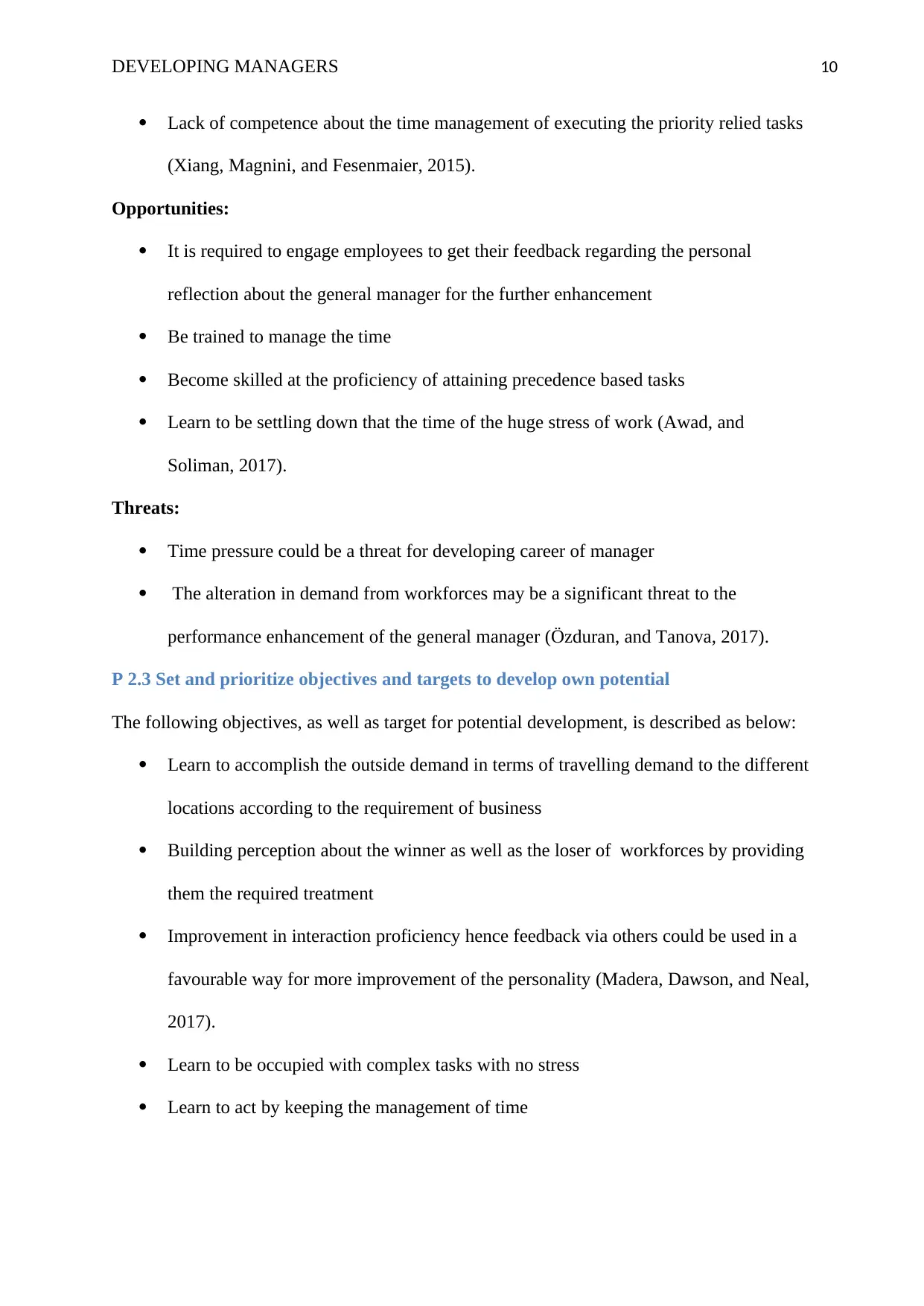
DEVELOPING MANAGERS 10
Lack of competence about the time management of executing the priority relied tasks
(Xiang, Magnini, and Fesenmaier, 2015).
Opportunities:
It is required to engage employees to get their feedback regarding the personal
reflection about the general manager for the further enhancement
Be trained to manage the time
Become skilled at the proficiency of attaining precedence based tasks
Learn to be settling down that the time of the huge stress of work (Awad, and
Soliman, 2017).
Threats:
Time pressure could be a threat for developing career of manager
The alteration in demand from workforces may be a significant threat to the
performance enhancement of the general manager (Özduran, and Tanova, 2017).
P 2.3 Set and prioritize objectives and targets to develop own potential
The following objectives, as well as target for potential development, is described as below:
Learn to accomplish the outside demand in terms of travelling demand to the different
locations according to the requirement of business
Building perception about the winner as well as the loser of workforces by providing
them the required treatment
Improvement in interaction proficiency hence feedback via others could be used in a
favourable way for more improvement of the personality (Madera, Dawson, and Neal,
2017).
Learn to be occupied with complex tasks with no stress
Learn to act by keeping the management of time
Lack of competence about the time management of executing the priority relied tasks
(Xiang, Magnini, and Fesenmaier, 2015).
Opportunities:
It is required to engage employees to get their feedback regarding the personal
reflection about the general manager for the further enhancement
Be trained to manage the time
Become skilled at the proficiency of attaining precedence based tasks
Learn to be settling down that the time of the huge stress of work (Awad, and
Soliman, 2017).
Threats:
Time pressure could be a threat for developing career of manager
The alteration in demand from workforces may be a significant threat to the
performance enhancement of the general manager (Özduran, and Tanova, 2017).
P 2.3 Set and prioritize objectives and targets to develop own potential
The following objectives, as well as target for potential development, is described as below:
Learn to accomplish the outside demand in terms of travelling demand to the different
locations according to the requirement of business
Building perception about the winner as well as the loser of workforces by providing
them the required treatment
Improvement in interaction proficiency hence feedback via others could be used in a
favourable way for more improvement of the personality (Madera, Dawson, and Neal,
2017).
Learn to be occupied with complex tasks with no stress
Learn to act by keeping the management of time
Paraphrase This Document
Need a fresh take? Get an instant paraphrase of this document with our AI Paraphraser
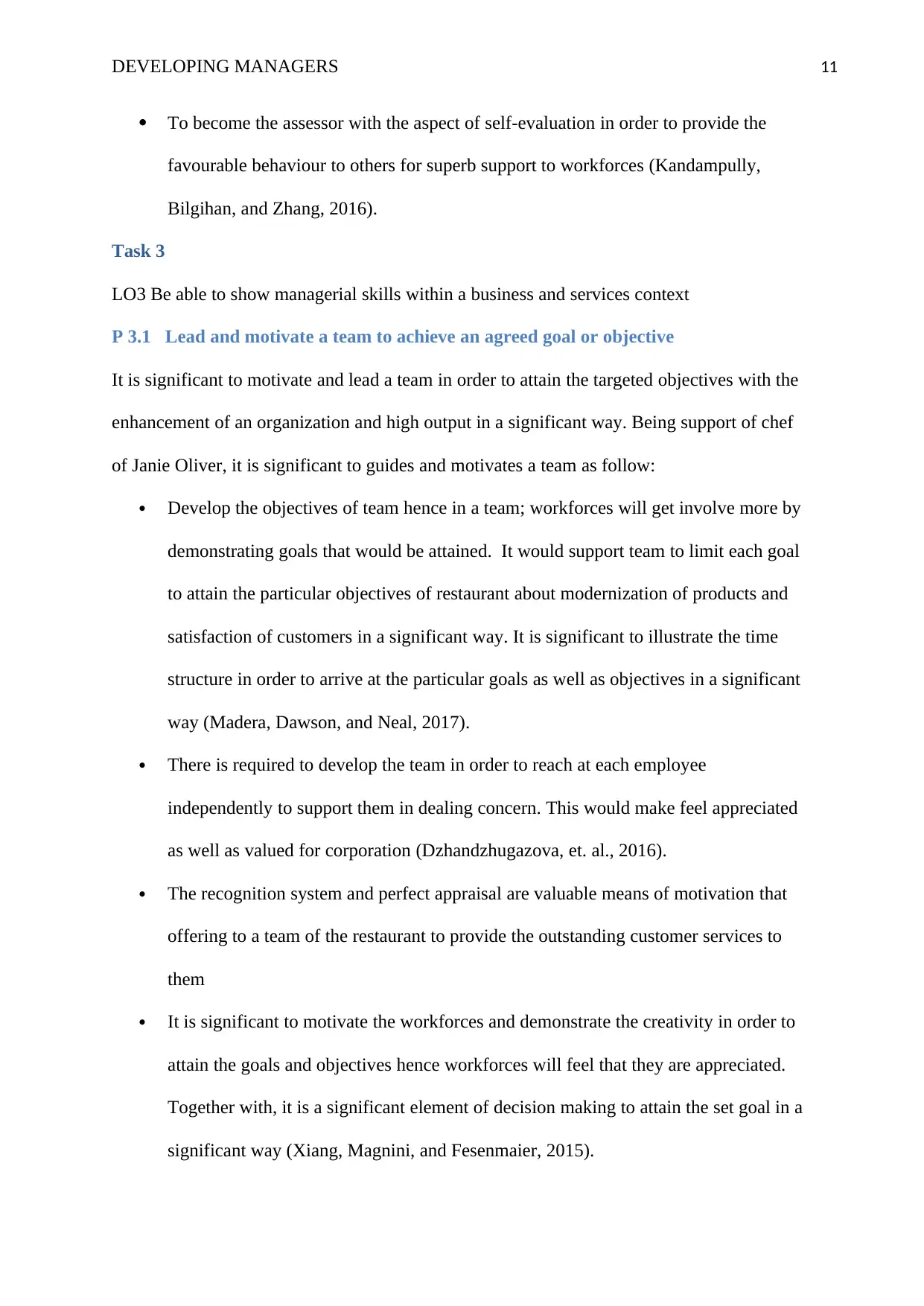
DEVELOPING MANAGERS 11
To become the assessor with the aspect of self-evaluation in order to provide the
favourable behaviour to others for superb support to workforces (Kandampully,
Bilgihan, and Zhang, 2016).
Task 3
LO3 Be able to show managerial skills within a business and services context
P 3.1 Lead and motivate a team to achieve an agreed goal or objective
It is significant to motivate and lead a team in order to attain the targeted objectives with the
enhancement of an organization and high output in a significant way. Being support of chef
of Janie Oliver, it is significant to guides and motivates a team as follow:
Develop the objectives of team hence in a team; workforces will get involve more by
demonstrating goals that would be attained. It would support team to limit each goal
to attain the particular objectives of restaurant about modernization of products and
satisfaction of customers in a significant way. It is significant to illustrate the time
structure in order to arrive at the particular goals as well as objectives in a significant
way (Madera, Dawson, and Neal, 2017).
There is required to develop the team in order to reach at each employee
independently to support them in dealing concern. This would make feel appreciated
as well as valued for corporation (Dzhandzhugazova, et. al., 2016).
The recognition system and perfect appraisal are valuable means of motivation that
offering to a team of the restaurant to provide the outstanding customer services to
them
It is significant to motivate the workforces and demonstrate the creativity in order to
attain the goals and objectives hence workforces will feel that they are appreciated.
Together with, it is a significant element of decision making to attain the set goal in a
significant way (Xiang, Magnini, and Fesenmaier, 2015).
To become the assessor with the aspect of self-evaluation in order to provide the
favourable behaviour to others for superb support to workforces (Kandampully,
Bilgihan, and Zhang, 2016).
Task 3
LO3 Be able to show managerial skills within a business and services context
P 3.1 Lead and motivate a team to achieve an agreed goal or objective
It is significant to motivate and lead a team in order to attain the targeted objectives with the
enhancement of an organization and high output in a significant way. Being support of chef
of Janie Oliver, it is significant to guides and motivates a team as follow:
Develop the objectives of team hence in a team; workforces will get involve more by
demonstrating goals that would be attained. It would support team to limit each goal
to attain the particular objectives of restaurant about modernization of products and
satisfaction of customers in a significant way. It is significant to illustrate the time
structure in order to arrive at the particular goals as well as objectives in a significant
way (Madera, Dawson, and Neal, 2017).
There is required to develop the team in order to reach at each employee
independently to support them in dealing concern. This would make feel appreciated
as well as valued for corporation (Dzhandzhugazova, et. al., 2016).
The recognition system and perfect appraisal are valuable means of motivation that
offering to a team of the restaurant to provide the outstanding customer services to
them
It is significant to motivate the workforces and demonstrate the creativity in order to
attain the goals and objectives hence workforces will feel that they are appreciated.
Together with, it is a significant element of decision making to attain the set goal in a
significant way (Xiang, Magnini, and Fesenmaier, 2015).

DEVELOPING MANAGERS 12
It is significant to provide better training and development sessions to employees
hence they would become familiar with the current market trend as well as the
requirement of customers in the market. Moreover, there is a general perception
regarding customers is to get products and services from the restaurants
(Kandampully, Bilgihan, and Zhang, 2016).
P 3.2 Justify managerial decisions made to support achievement of agreed goal or
objective and recommendations for improvements.
It is required to think with the viewpoint of workforces hence the team will receive the
accurate data set due to effective training from the managers. For making a career in the
hospitality industry, there is high up-gradation of skills of workforces to accomplish the
requirement and demand of customers in the restaurant. Under team, workforces are
encouraged to reveals their innovation proficiency and their significant decision-making
proficiency in order to attain target individually. It could be evaluated that the democratic
managerial style is a significant style for the managers to sustain in the Hotel. As the trend of
market is changing with time hence a company should focuses on strict managerial style for
making their decision without hiring manager. Moreover, judgement procedures for these
managers are not justifiable (Awad, and Soliman, 2017).
With the support of democratic style, managers would be competent to attain different
hierarchical requirement according to Maslow’s hierarchical needs of motivation in a
significant way. With the active accommodating nature of managers, high-quality reward
systems and good appraisal can attain all the level of Maslow’s hierarchical requirements
hence, the workforces in the restaurant would feel more encouraged in a significant way
(Wang, and Chung, 2015).
It is suggested that company should get the feedback from the consumers about the
customer’s services that are provided by the line managers so that line managers would be
It is significant to provide better training and development sessions to employees
hence they would become familiar with the current market trend as well as the
requirement of customers in the market. Moreover, there is a general perception
regarding customers is to get products and services from the restaurants
(Kandampully, Bilgihan, and Zhang, 2016).
P 3.2 Justify managerial decisions made to support achievement of agreed goal or
objective and recommendations for improvements.
It is required to think with the viewpoint of workforces hence the team will receive the
accurate data set due to effective training from the managers. For making a career in the
hospitality industry, there is high up-gradation of skills of workforces to accomplish the
requirement and demand of customers in the restaurant. Under team, workforces are
encouraged to reveals their innovation proficiency and their significant decision-making
proficiency in order to attain target individually. It could be evaluated that the democratic
managerial style is a significant style for the managers to sustain in the Hotel. As the trend of
market is changing with time hence a company should focuses on strict managerial style for
making their decision without hiring manager. Moreover, judgement procedures for these
managers are not justifiable (Awad, and Soliman, 2017).
With the support of democratic style, managers would be competent to attain different
hierarchical requirement according to Maslow’s hierarchical needs of motivation in a
significant way. With the active accommodating nature of managers, high-quality reward
systems and good appraisal can attain all the level of Maslow’s hierarchical requirements
hence, the workforces in the restaurant would feel more encouraged in a significant way
(Wang, and Chung, 2015).
It is suggested that company should get the feedback from the consumers about the
customer’s services that are provided by the line managers so that line managers would be
⊘ This is a preview!⊘
Do you want full access?
Subscribe today to unlock all pages.

Trusted by 1+ million students worldwide
1 out of 18
Related Documents
Your All-in-One AI-Powered Toolkit for Academic Success.
+13062052269
info@desklib.com
Available 24*7 on WhatsApp / Email
![[object Object]](/_next/static/media/star-bottom.7253800d.svg)
Unlock your academic potential
Copyright © 2020–2025 A2Z Services. All Rights Reserved. Developed and managed by ZUCOL.





